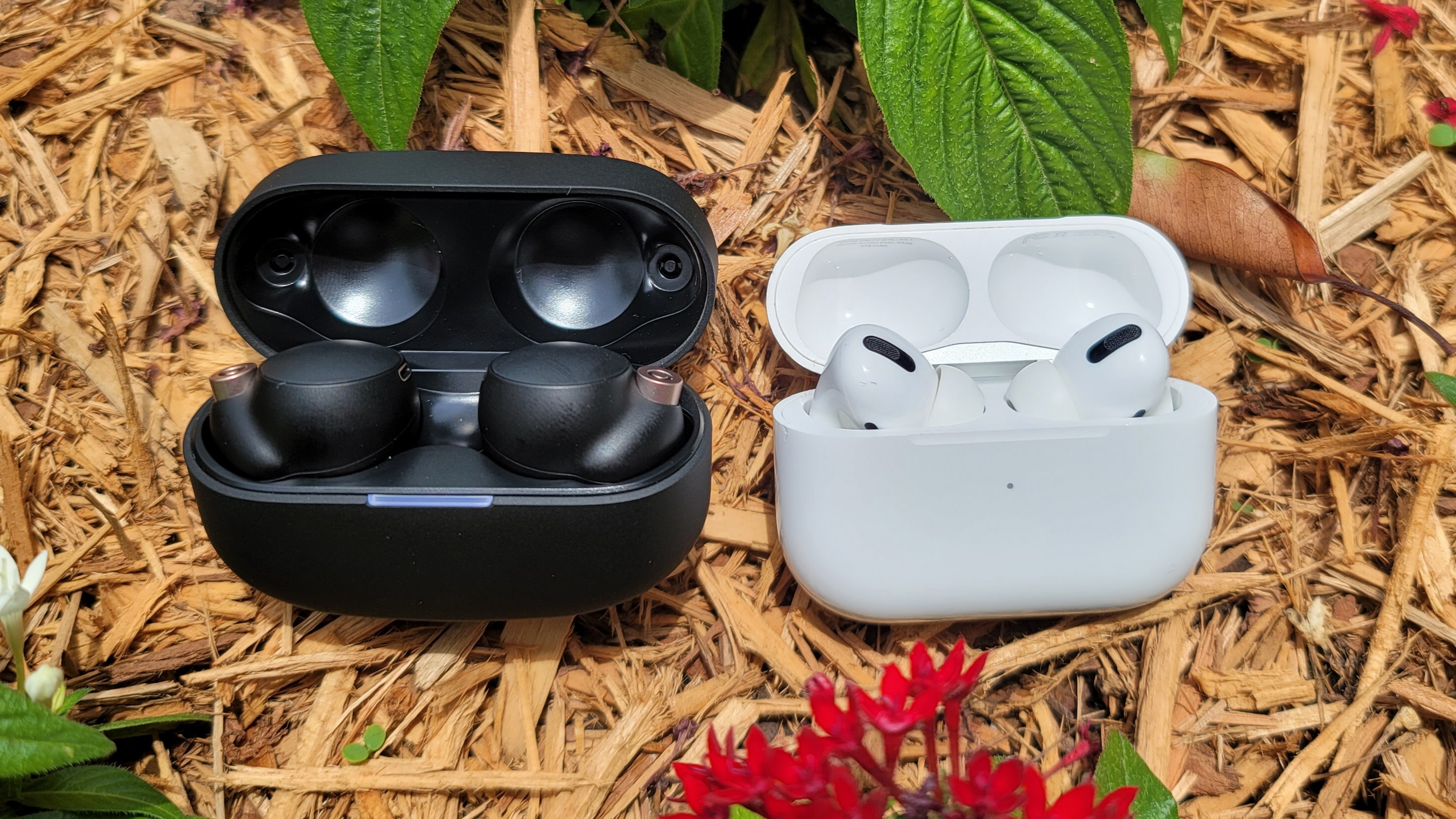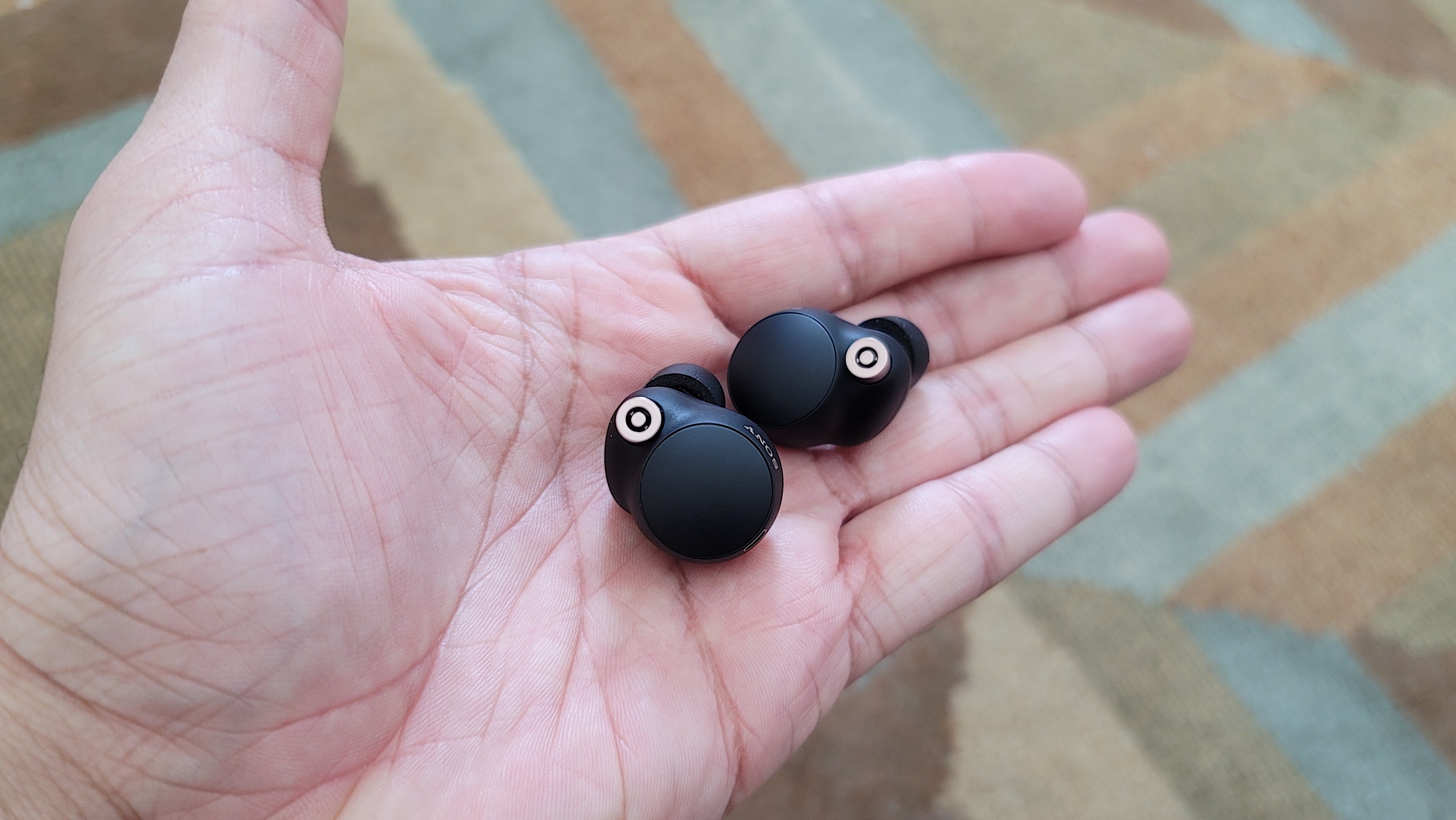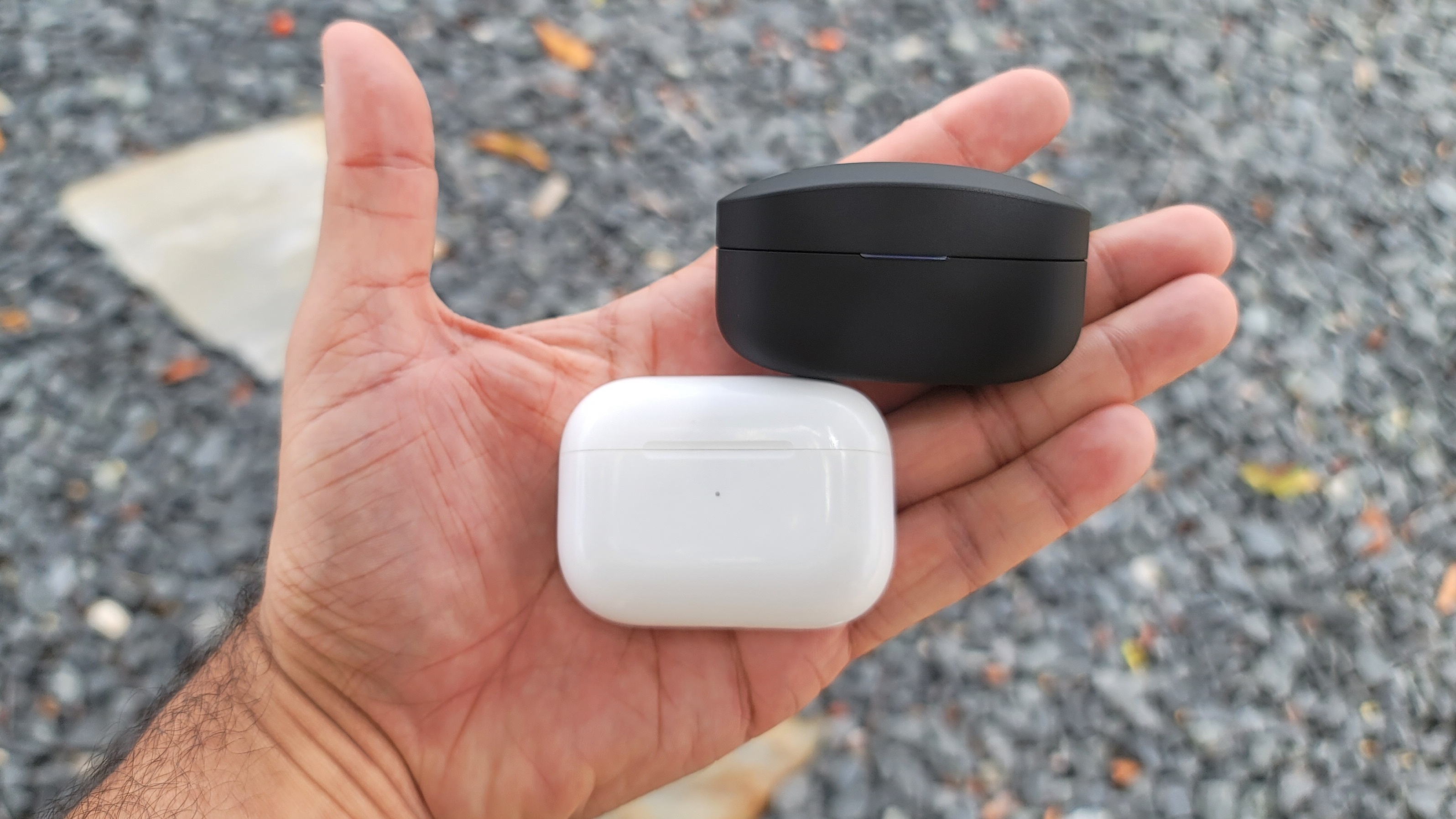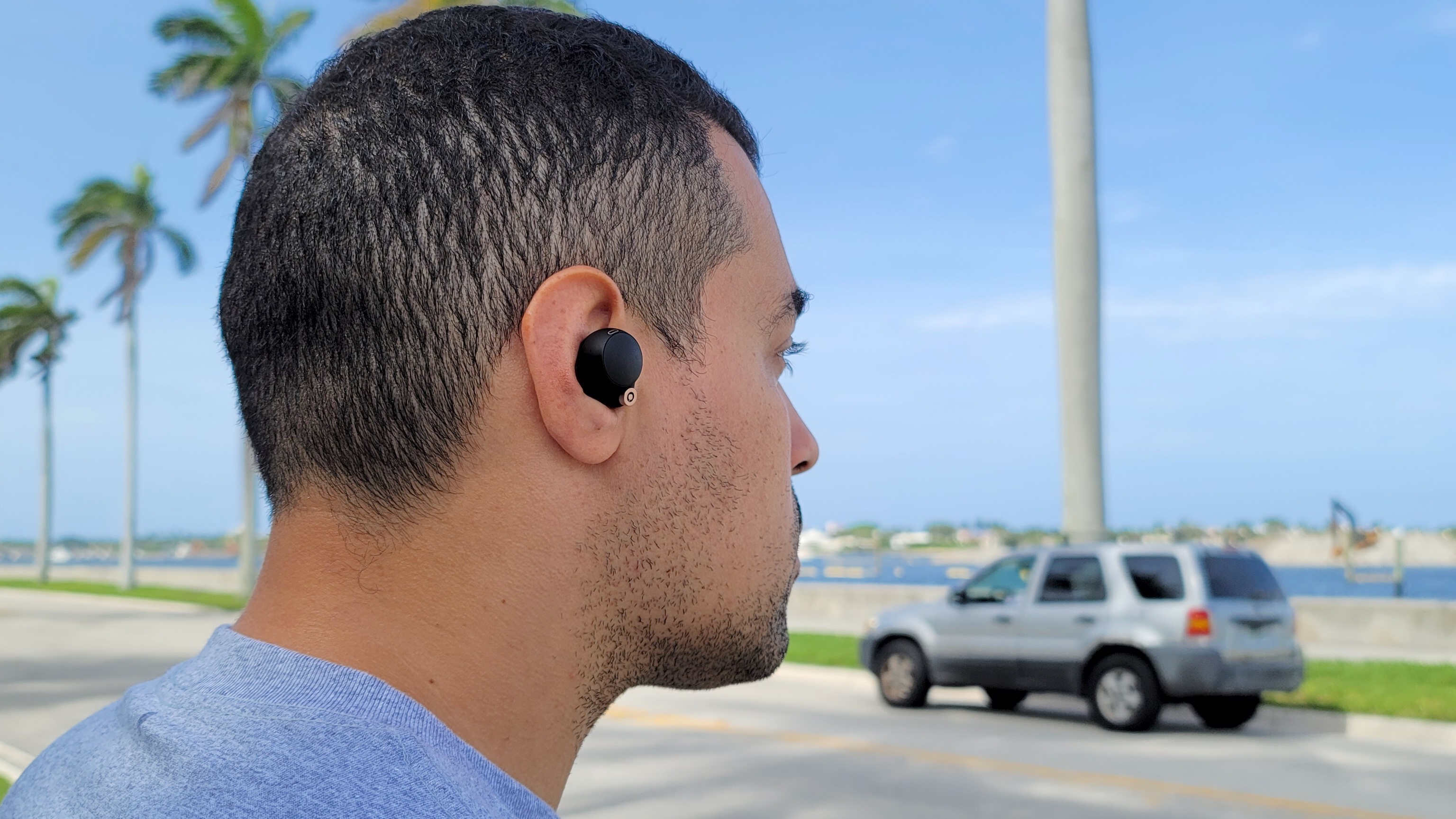Sony WF-1000XM4 vs. AirPods Pro: Which noise-cancelling earbuds are best?
Has a new true wireless king emerged?

This battle pits the new Sony WF-1000XM4 against the popular AirPods Pro, breaking down the better noise-canceling wireless earbuds.
The Sony WF-1000XM4 is a remarkable sequel to the model that made active noise cancellation legitimate in the true wireless space: the Sony WF-1000XM3. Improved ANC, longer battery life, refined sound, and a plethora of features give these buds well-rounded performance. Also, you can’t discuss the WF-1000XM4 without bringing up its handsome new design, which Sony claims has been ergonomically improved for a more stable fit.
- Best wireless earbuds, per style and budget
- Best noise-cancelling headphones in 2021
- Best cheap headphones deals
Nearly two years strong on the market and the AirPods Pro has sat at the top of the true wireless class. Adaptive sound, customizable fit, impressive ANC, and instant connectivity with iOS/macOS devices, Apple’s flagship buds are practically perfect. New iOS updates continue to expand functionality on these porcelain noise-cancellers, extending their shelf life until the highly rumored AirPods Pro 2 becomes official.
Both of these releases were designed to deliver high-level performance and meet numerous needs, but you want to know which is worth owning? Check out our in-depth comparison of the Sony WF-1000XM4 and AirPods Pro, which declares the superior model.
Sony WF-1000XM4 vs. AirPods Pro: Specs
| Header Cell - Column 0 | Sony WF-1000XM4 | AirPods Pro |
|---|---|---|
| Price | $279 | $249 |
| Wireless charging | Yes | Yes |
| Processor | Sony V1 | H1 |
| Battery life (rated) | 8 hours (ANC on), 12 hours (ANC off), 24 hours (with charging case), 36 hours (with charging case and ANC off) | 4.5 hours (ANC on), 5 hours (ANC off), 24 hours (with charging case) |
| IPX rating | IPX4 | IPX4 |
| Size and weight (buds) | 1 x 0.81; 0.2 ounces | 1.22 x 0.86 x 0.94 inches, 0.19 ounces |
| Size and weight (charging case) | 2.4 x 1.5 x 1.1 inches, 2 ounces | 1.8 x 0.9 x 2.4 inches, 1.6 ounces |
| Special features: | Active noise cancellation, transparency mode, Speak-to-Chat, customizable EQ, 360 Reality Audio, DSEE Extreme upscaling, LDAC, Bluetooth 5.2, tri-digital assistant support (Alexa, Google Assistant, and Siri), quick charging | Active noise cancellation, transparency mode, adaptive EQ, spatial audio, automatic switching, customizable fit, audio sharing, Fast Fuel charging, announced messages with Siri, “Hey Siri” voice-activated assistance, wireless charging case |
Sony WF-1000XM4 vs. AirPods Pro: Price
The AirPods Pro has a major advantage in price. Not because it is listed lower at $249, but because it’s often marked down with some retailers dropping the price to as low as $180. Target has them on sale for $199 and a refurbished pair can be purchased for $175 on Best Buy.
Knowing that Sony launched the WH-1000XM3 at $229, it’s a bit of a shocker to see the WF-1000XM4 carry a higher MSRP at $279. This places it in the same price class as the Bose QuietComfort Earbuds ($279) and slightly below the Master & Dynamic MW08 ($299).
Specs alone make Sony’s buds worth the splurge. At the same time, Apple’s buds are reasonably attainable, and you’d be foolish not to pick them up at such a generous discount right now.
Sign up to receive The Snapshot, a free special dispatch from Laptop Mag, in your inbox.
For all of the latest headphones deals, we advise bookmarking our best headphones deals and best Apple deals pages.
Winner: AirPods Pro
Sony WF-1000XM4 vs. AirPods Pro: Design

When constructing the WF-1000XM4, Sony had ergonomics and size in mind. The last in-ear Mark series creation was chunky and wide, whereas the latest version is oval and smaller to occupy every bit of space on your ear. Details like the protruding shape, large touch panels, and copper ANC mic housings are striking. The inky black-matte plastic feels sturdy and an IPX4 rating gives these buds the same sweat and water-resistant protection as the AirPods Pro.

Many people knock Apple’s long-stem design, and though the AirPods Pro isn’t that different from its predecessors, there are notable details that make it distinctive. These include a longer sound port, shorter stems, black vents, silver accents, haptic sensors, and the installed ear tips. Unfortunately, the plastic casing is a scratch-and-scuff magnet and will easily break if you step on the buds.

Sony didn’t just give its wireless earbuds a makeover, but also the charging case, which is smaller than the cigarette holder-inspired WF-1000XM3 case and resembles the WF-SP800N case. It works for us, primarily because it’s portable-friendly. The AirPods Pro’s charging case is a step up from the AirPods 2 case and has a slightly stronger build quality. Small details like a pairing button in the back are useful when connecting to non-Apple devices. You won’t have any issues sliding either of these cases into your tight denim pockets.

The WF-1000XM4 (0.2 ounces) offers relative comfort. Adjusting the buds properly will allow them to rest properly on the concha, but it’ll require several attempts before succeeding. Our advice is to use the silicone tips in the box over the memory foam tips because they provide a better seal and don’t apply pressure around the ear canal, which can be fatiguing after about two hours of wear.

The AirPods Pro are not only lighter (0.19 oz.), but also provide better long-term comfort and fit. Apple’s ear tips create a tight seal that keeps the buds locked in and the sound port rests gently on the concha and intertribal notch.
Both models come with their own ear tip fit tests to achieve optimal fit. You’ll want to go by the feedback each program provides because it will enhance audio quality and noise cancellation.
Winner: Sony WF-1000XM4
Sony WF-1000xM4 vs. AirPods Pro: Controls

The WH-1000XM3 had some of the worst controls in the category, but Sony fixed them on the WF-1000XM4. A full suite of controls is programmed into the buds, including playback, call management, listening mode activation, digital assistance, and volume. Each one can be executed in quick fashion, thanks to responsive tap and long-press gestures.
On-ear detection is also on point to automatically pause playback when removing the buds from your ears. Sony even added a few more smart controls to make operating the WH-1000XM4 a breeze. Speak-to-Chat will pause music every time the mics recognize your voice and Quick Attention acts as a shortcut to Ambient Sound Control, dropping volume down to about 10 percent to hear what’s happening around you. Google Assistant and Alexa integration come part of the package and work well for voice commands; speaking either AI bot’s action phrase (“Hey Google”, “Alexa”) activates the feature. Siri is supported as well.
As great of an effort as Sony puts in, it’s tough to compete with the AirPods Pro’s accurate and highly responsive control scheme. The innovative force sensor system registers every press and executes intended commands swiftly. Motion detection is stellar, automatically pausing content when removing the buds and resuming playback when placed back on your ears, lag-free. However, it’s all about hands-free “Hey Siri” voice activation. Apple’s dual-mic array is intelligible and picks up vocals and commands with precision.
Winner: AirPods Pro
Sony WF-1000XM4 vs. AirPods Pro: Active noise cancellation

The WF-1000XM3 outperformed the AirPods Pro in noise cancellation, and so do the WF-1000XM4. Sony’s ANC technology is even stronger this time around and resiliently decreases external noises across the frequency spectrum. We found the buds useful for numerous scenarios, from hushing keyboard clatter to rowdy commuters to most construction work. The buds also do a fine job of reducing both AC and truck engine humming. For those worried about using the buds in gusty conditions, a Wind Reduction mode was added to diminish whooshing effects, and it’s pretty decent.
Ambient Sound Control is Sony’s version of transparency mode, and the feature is ridiculously powerful with up to 20 levels of adjustable ambient listening. The higher you go, the more noise you let in, which the WF-1000XM4 does exceptionally well. If you want to eavesdrop on conversations or engage in brief chats without removing the buds, there is a “focus on voice” option that increases clarity to hear people more clearly. In addition, you can turn on automatic switching to keep track of your frequent locations and activities, so the feature can learn which ambient settings work best in the situation.

Transparency Mode on the AirPods Pro is reliable for gaining greater awareness of surroundings. Oftentimes, we employed the feature to communicate with baristas and hear announcements over the grocery store speaker system. Apple also introduced a Headphone Accommodations feature that transforms the buds into hearing aids, making quiet noises more audible and tuning environmental sounds to your hearing.
Apple’s two-mic noise-cancelling array is surprisingly good at blocking out most external sounds. The technology sufficed for quieting chatty siblings, loud TVs, and kitchen appliance timers. Outside was just as rewarding with obnoxiously talkative joggers and whisking cars going mute.
High-frequency sounds are unavoidable no matter which of these sets of buds you’re using, but the WH-1000XM4 makes them sound like background effects on songs.
Winner: Sony WF-1000XM4
Sony WF-1000xM4 vs. AirPods Pro: Audio

Sony never disappoints when it comes to sound. The new Sony V1 chip is designed to simultaneously reduce distortion and enhance audio quality on the WH-1000XM4. Bass is toned down, something that might displease WH-1000XM3 lovers, but this was done for the greater good. What you’re getting is vibrant, full-bodied sound that complements all media formats (e.g., music, movies, podcasts, eBooks). Highs are accurate, mids are highly detailed, and lows remain rich and impactful despite being brought down a notch. 360 Reality Audio creates a spatial 3D audio soundscape that can be enjoyed on compatible hi-res music services (e.g., Tidal, Deezer). LDAC, AAC, and SBC codecs also ensure high-quality streaming over Bluetooth.
Apple’s adaptive EQ does improve sound quality and gives the AirPods Pro a warm and wider soundstage to hear individual instruments and mids more clearly. Lows are emphasized as well. Highs aren’t handled well, and you’ll often miss out on them when indulging in bass-heavy tracks. The addition of spatial audio does add an extra layer of sound to the AirPods Pro, presenting selected Apple Music tracks and Dolby-Atmos-supported videos in a 3D format for an immersive listening experience.
Winner: Sony WF-1000XM4
Sony WF-1000XM4 vs. AirPods Pro: App and special features

Both pairs of buds are nearly equal in the features department, but the WF-1000XM4 has the more enticing selection. That doesn’t take away from Apple continuing to do a phenomenal job of bringing new functionality to the AirPods Pro, even without a companion app.
The Sony Headphones Connect app acts as the central hub for all features on the WF-1000XM4, and there is a lot to digest. Fortunately, we already touched on several of these features, including 360 Reality Audio, ANC, ambient listening adjustment, DSEE Extreme, Quick Attention, and Speak-to-Chat. Let’s discuss the rest.
Sony gives you an Equalizer to personalize audio, either by creating your own sound profile or selecting from eight superbly engineered presets: Bass Boost, Bright, Excited, Mellow, Relaxed, Treble Boost, Speech, and Vocal. Underneath this is a Bluetooth Connection Quality setting to prioritize connectivity or sound quality; this is great for those who prefer one over the other. Battery level indicators for both earbuds and the charging case, toggle controls for multiple functions, a music player, and firmware updates make up the rest of the app. We just wish there was a Find My Buds feature.
On top of “Hey Siri” assistant activation and spatial audio, the AirPods Pro hosts numerous other software perks. The H1 chip lets users take advantage of auto-switching between iCloud-registered devices, finding misplaced or lost buds, Siri Announce Notifications, and sharing audio between two Apple/Beats headphones sharing the same chipset. It can also learn your daily charging routine to preserve battery health over time.
Apple also grants access to other features through iOS for enhanced performance. Most listeners will jump at the opportunity to switch out the EQ, which can be found in the Settings and has over 20 different presets to choose from. This is where you’ll be able to customize the controls as well.
The WH-1000XM4 runs on Bluetooth 5.2, giving it fast and strong connectivity, plus one-touch pairing with Android devices via Google Fast Pair. The AirPods Pro uses Bluetooth 5.0, but operates just as smoothly, and is designed to automatically connect with iDevices.
Multipoint technology isn’t available on either model. On top of that, Sony’s decision to remove NFC from the WF-1000XM4’s spec sheet is one that doesn’t sit well with us.
Winner: Sony WF-1000XM4
Sony WF-1000xM4 vs. AirPods Pro: Battery Life

The WF-1000XM3 set the bar for battery life on wireless ANC earbuds when it launched, and the WF-1000XM4 takes it a level higher. ANC playtime is given a generous boost from 6 to 8 hours, which is realistically 7 hours or 7.5 hours when factoring in volume, streaming, and numerous features running in the background. We’ll take that any day over the AirPods Pro’s measly 4.5 hours. You can also extend playtimes to 12 hours when disabling ANC, a much higher number than the extra 30 minutes Apple gives you when turning off the AirPods Pro’s noise cancellation.

Quick charging is equally strong on both models: a 5-minute charge allows for about 1 hour of use. Each charging case comes with wireless charging, though we noticed the WF-1000XM4 as a whole tends to overheat when charging longer than 30 minutes. Sony’s case can hold between 24 to 36 hours when fully charged, depending on how you use the buds. The AirPods Pro’s case maxes out at 24 hours.
Winner: Sony WF-1000XM4
Sony WF-1000xM4 vs. AirPods Pro: Call Quality

The only model that tops the AirPods Pro in call quality is the QuietComfort Earbuds. Apple’s mics perform double the work, capturing every word spoken for clear-sounding conversations while reducing the presence of external sounds. The strong seal produced by the ear tips is essential for hearing calls better. Also, the H1 chip gives you 50% more talk time than the original AirPods.

Considering how bad the WF-1000XM3 performed as a calling headset, expectations were high for its successor to right this wrong. That didn’t happen. The WF-1000XM4 suffers from lots of muffling and lets in too much ambient noise during conversations. Wind resistance is decent, but not better than the AirPods Pro. We only found the buds serviceable during indoor video chats, granted, it required being in quiet settings.
Winner: AirPods Pro
Overall winner: Sony WF-1000XM4
The Sony WF-1000XM4 is a force to be reckoned with. Hi-fi sound combined with powerful noise cancellation and some of the best audio features you’ll find of a pair of wireless buds makes it the new category leader. The increased battery life is highly appreciated, and more importantly, the ultra-powerful quick charging. Even if the revamped design fails to deliver on comfort, it’s hard to deny its aesthetic appeal. It would have been nice if Sony included standard features like a Find My Buds function and proprietary NFC, but these are small compromises when evaluating the WF-1000XM4’s overall performance.
| Header Cell - Column 0 | Sony WF-1000XM4 | AirPods Pro |
|---|---|---|
| Value (5) | 4 | 5 |
| Design (15) | 12 | 11 |
| Controls (10) | 9 | 10 |
| Active noise cancellation (20) | 19 | 17 |
| Audio (15) | 14 | 12 |
| App and special features (15) | 13 | 12 |
| Battery life (10) | 9 | 7 |
| Call quality (10) | 6 | 10 |
| Total score (100) | 86 | 84 |
For the AirPods Pro, it’s all about the user experience. Impeccable Siri operation, speedy connectivity, and iCloud support make these buds an ideal companion for all iPhone owners. Sound is satisfying, thanks to a cleaner sound profile and spatial audio support, while ANC works well to block out the majority of incidental noises during listens. Apple’s ever-growing list of features keeps its buds up to date as well. Say what you will about the boring design or weak battery life, but even minor upgrades like the installed tips and battery optimization make the most out of those situations. However, the competition has caught up and Sony now wears the true wireless crown.
Alex Bracetti writes about all things related to audio at Laptop Mag. From insightful reviews of Sony earbuds to hands-on experience with the Beats Studio Pro, Alex covers everything you need to know in order to buy the best pair of headphones or earbuds. Alex has also written about speakers and audio apps. Outside of Laptop Mag, Alex's work has appeared in our sister site Tom's Guide.



